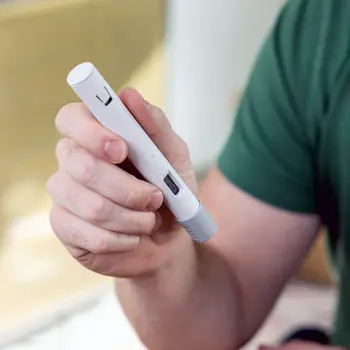‘Ozempic Butt’: Everything You Need to Know About this Post-Weight-Loss Phenomenon
With the rising demand for effective weight loss strategies, more and more people are exploring the use of weight loss drugs. In fact, it’s estimated that 15 million Americans will be on weight loss medications by 2030.
New research shows that at least 53% of Americans who are familiar with drugs like Ozempic view them as effective treatments for obesity and other weight-related health conditions.
However, if you’ve heard of Ozempic, you’ve likely also heard about its side effects — such as Ozempic face and Ozempic butt.
In this article, we’ll answer your questions about Ozempic butt, identify those who are most susceptible to it, and provide treatment strategies.
Get prescription weight loss medication online.
Find out if you're eligible for GLP-1s, and get started on your weight loss journey for as low as $75/month.


What is Ozempic Butt?
Ozempic is a type two diabetes medication that has recently gained popularity as an off-label solution to obesity.
Ozempic butt and Ozempic face refer to the sagged appearance of the buttocks and face due to rapid weight loss caused by the medication.
What Causes Ozempic Butt?
Ozempic butt results from the quick weight loss experienced with this medication – particularly affecting the face and buttocks – where the impact is most pronounced.
Because Ozempic accelerates weight loss so rapidly, the skin can't contract quickly enough to match the body's reduction in size.
In addition to this quick fat loss, the body also loses skin elasticity when you lose a significant amount of weight fast.
This results in excess sagging and loose skin, more skin folds and wrinkles, and a generally deflated appearance — which is a common issue with many weight loss medications that don’t consider skin elasticity.
Whereas gradual weight loss allows the skin to naturally adjust and tighten around a smaller body frame, rapid weight loss can leave you looking deflated — almost like a balloon that’s lost its air.
Who is Most Likely to Experience Ozempic Butt?
Rapid or drastic weight loss can lead to unforeseen outcomes, including sagging skin on the buttocks, particularly among those who take weight loss drugs like Ozempic.
Individuals most likely to experience sagging skin after weight loss include:
Those on restrictive diets or using weight loss medications
The sagging skin linked to Ozempic use may also be experienced by anyone taking other weight loss medications, those adhering to overly restrictive diets, or individuals experiencing significant weight loss in a short timeframe.
These scenarios share a common outcome: rapid fat reduction that the skin cannot keep up with, resulting in a saggy appearance.
Older individuals
Age plays a crucial role in skin elasticity. As our skin ages, it undergoes the process of elastosis whereby it naturally loses its elasticity and its ability to "bounce back".
Therefore, the older you are, the more likely you are to experience saggier skin following rapid weight loss.
Unintentional weight loss
Currently, approximately 8% of adults are at risk of developing conditions that lead to unintentional weight loss. Significant factors contributing to such weight loss include:
Mental health challenges, including depression and anxiety
Ongoing or intense stress
Various medical conditions like diabetes, heart problems, or hyperthyroidism
Cancer
Digestive disorders such as coeliac disease or irritable bowel syndrome (IBS)
Key Point: Will Ozempic Make Me Lose My BBL?
Since Ozempic leads to fat reduction, it can impact the results of those who have had a Brazilian butt lift done prior to taking Ozempic.
Our bodies do not have the ability to selectively target fat loss in specific areas; instead, fat is lost in a general pattern across the body.
As a result, preserving the fat – specifically in the buttocks area – is challenging. Nonetheless, there are techniques and procedures available that can help maintain your desired buttocks shape after losing weight with Ozempic.
How Do You Treat Ozempic Butt?
Ozempic butt can be treated in a variety of ways. The aim is to reduce the appearance of deflation and volume loss. The following are a few commonly used methods:
Cosmetic procedures
Surgical interventions
Gluteal fat grafting or Brazilian butt lift (BBL): This procedure involves transferring fat deposits from another area of the body, such as the lower back, thighs, or abdomen, to the buttocks to create a fuller appearance.
This is the most common method of gluteal augmentation. It is also the most studied method in the U.S., accounting for 42.28% of the research on the subject.
The primary complication of buttock augmentation via fat grafting is the risk of a fat embolism, which occurs when fat globules enter the bloodstream and block a small vessel.
This blockage disrupts the normal function of the affected organ or structure, potentially leading to its failure or even death.
Gluteal implants: Custom silicone implants can enhance buttock volume, and a study involving 86 patients aged 26 to 46 showed high success rates using these implants in conjunction with lipoplasty.
Lipoplasty – or liposuction – is a procedure that removes excess fat, helping to sculpt the body into the desired shape.
Gluteal tissue flaps: This technique uses excess dermal and fat tissue from above the gluteal area, repurposing it as an autologous implant (an implant made from the person’s own tissue) by creating a flap and folding it over.
A 2008 study demonstrated that using tissue flaps for buttock augmentation effectively enhanced the contour of participants' buttocks.
Nonsurgical interventions
The media often focuses on individuals who have had cosmetic surgery – frequently referred to as having "work done" or "going under the knife" – emphasizing surgical interventions.
Yet, there are numerous conservative or nonsurgical approaches to address sagging skin that resulted from rapid weight loss.
Biodegradable fillers: An individualized and targeted treatment involving the injection of Poly-L-Lactic acid (PLLA) into the buttocks. This approach has been proven to enhance the shape and lift of the buttocks while also reducing skin laxity.
Radiofrequency butt lift: In this procedure, the skin's dermis is heated to redistribute fat and boost skin elasticity, leading to collagen regeneration and reorganization. This process helps restore some of the skin's elasticity and smoothness in the buttocks area.
Be patient and protect your skin
Stretched or saggy skin can gradually regain a tighter appearance if an individual maintains their new body weight for at least a year.
During this period, it's advised to keep the skin healthy and hydrated to preserve its elasticity as much as possible.
Be mindful of the sun and the damage it can do to your skin. Always wear sunscreen when you are exposed to sunlight.
The American Academy of Dermatology (AAD) recommends the following when it comes to suncare:
Try to limit your sun exposure during peak times between 10 a.m. and 2 p.m.
Use a sunscreen of at least SPF30 on all parts of your body that are exposed to the sun.
Remember to reapply your sunscreen every 2 hours.
Apply your sunscreen, even on rainy and cloudy days.
Exercise and diet
No exercise can fully restore skin elasticity once it's overstretched.
You can, however, improve your buttocks' shape and appearance by building lean muscle, particularly in the lower body, to give it a firmer, rounder look that offsets looser skin.
A balanced diet rich in lean protein is also crucial for muscle development.
The American Heart Association (AHA) recommends the following:
At least 150 minutes of moderate physical activity or 75 minutes of vigorous physical activity per week.
Resistance training twice per week to build muscle, increasing the weight and intensity as you strengthen your body.
Ready to achieve your weight loss goals?
Shed pounds with GLP-1 medication prescribed online by licensed healthcare providers for as low as $75/month.


When Should You See a Doctor for Saggy Skin Caused by Ozempic?
You should seek medical attention if Ozempic-induced skin changes distress you for any of these reasons:
Cosmetic concerns: If you’re unhappy with your appearance due to excess skin and it’s starting to affect your self-esteem.
Mental health: If you have a history of mental illness associated with body image or you suffer from body dysmorphia.
Functional disruption: If the excess skin following your weight loss starts to inconvenience your daily life by causing issues such as clothing fit problems, hygiene difficulties, excessive sweating, or body odor.
Skin conditions: If you’re experiencing skin irritations or infections — such as intertrigo, dermatitis, or fungus — due to moisture buildup in the skin folds.
Where Can You Learn More About Managing Ozempic Side Effects?
If you want to lose weight but you’re concerned about the potential side effects of a weight loss drug like Ozempic, LifeMD may be able to help.
A team of healthcare professionals can answer all your questions related to sustainable weight management on your health journey and help you create a plan for losing weight.
If you are interested in medications like Ozempic, the LifeMD Weight Management Program offers access to innovative medications combined with ongoing clinical support. Just answer some questions about your medical history and your weight loss goals to find out if you’re eligible.
More articles like this
Feel better with LifeMD.
Your doctor is online and ready to see you.
Join LifeMD for seamless, personalized care — combining expert medical guidance, convenient prescriptions, and 24/7 virtual access to urgent and primary care.

GLP-1
Zepbound® Wegovy® Saxenda®
This is it! Be part of the weight loss movement everyone’s talking about.
Get Started Now
 Medically reviewed and edited by
Medically reviewed and edited by 








